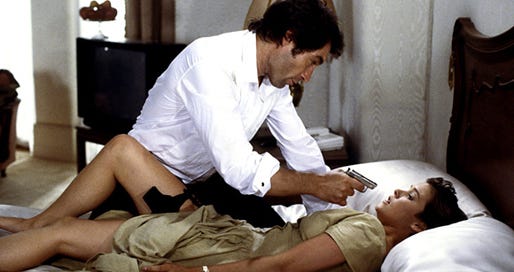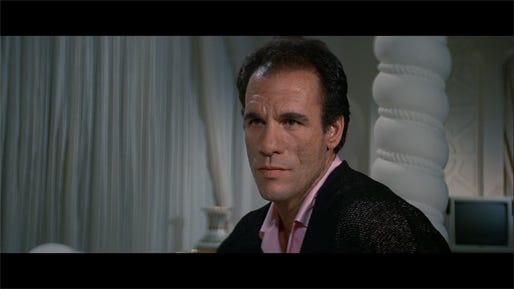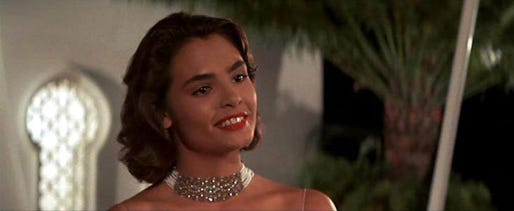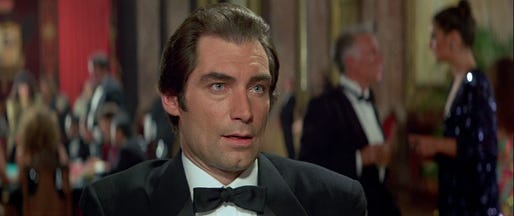You Only Live Twenty-Thrice: "Licence to Kill"
“You Only Live Twenty-Thrice” is a look back at the James Bond films.
Each Friday until the release of the 23rd official Bond film, “Skyfall,” we will revisit its 22 official predecessors from start to finish, with a bonus post for the unofficial films in which James Bond also appears.
For movie-loving kids of the 1980s permitted to exceed PG parameters, no summer topped the summer of 1989.
Indiana Jones and Batman within weeks, one franchise then ending and another beginning. A slew of comedies that was sophisticated (“When Harry Met Sally …”), screwball (“See No Evil, Hear No Evil”), sweet (“Parenthood”) and surreal (“UHF”).
Spike Lee and Steven Soderbergh arriving with authority in “Do the Right Thing” and “sex, lies and videotape.” The rated-R-for-everything redneck romp of “Road House.” James Cameron’s criminally undervalued “The Abyss.” The shoestring-budget suspense of “Miracle Mile.” Dead poets. Shrunken kids. Returned swamp things. Hulk Hogan. Nearly every weekend a new delight, many now gracefully aged.
It was also a summer that saw James Bond as odd man out in the action realm. The 007 series was no stranger to biennial seismic shifts, but those involved casting. How would Bond fare not only against increasingly elaborate action blockbusters, but a burgeoning bang-bang subgenre with traumatized cops as heroes?
Martin Riggs was an unhinged, suicidal loose cannon (who returned for round two that same summer). Alex Murphy fought to retain his humanity in a cybernetically reprogrammed body. John McClane ran across broken glass and jumped off a skyscraper to save a woman he wasn’t sure loved him anymore. Yes, Timothy Dalton gave 007 brief flickers of darkness and fury in “The Living Daylights,” but compared to these broken souls, Bond felt cucumber-cool.
“Licence to Kill” set out to explicitly change that conception of the character — sending 007 off the official books to grapple with a cocaine cartel and his own moral code. Almost immediately, it’s a noticeably broodier, moodier Bond — barking at blokes to piss off, offering no quarter to foes, and avenging married friends’ mutilation, rape and murder with kills that were colder, more calculated and, in a first that became the standard, rated PG-13.
Even the introductory gun-barrel fanfare is markedly different, nearly supplanting the “James Bond Theme” with melodramatic, timpani-driven stage dressing for the engorged, operatic emotions that are to come.
So while only Indy and Batman made more cash that year than the return of Riggs and Murtaugh, how did Bond fare? Considering that it grossed less in America than, uh, “Fletch Lives,” not very well. And although a robust international performance saved its bacon, “Licence” became the first Bond film to not match its production budget with U.S. grosses alone. Were it not for bad luck, Dalton’s 007 films had no box office luck at all. When Daniel Craig went rogue and avenged a woman’s murder in 2008’s “Quantum of Solace,” it was a top-10 earner for that year.
And just as Jason Bourne’s anxious aesthetic informed “Quantum’s” journeyman quality, “Licence” is similarly influenced by Riggs, McClane and the like.
The movie was originally titled “Licence Revoked” but was renamed when that sounded more like the dictum of the American DMV, not Her Majesty’s Secret Service. But when Bond tenders his resignation, he’s like a cavalier cop with a bad attitude brought before the sarge. One that cracks a Hemingway joke, mind you.
We’re not accustomed to seeing this unvarnished, eye-for-an-eye morality or a reversal of fortune in Bond. And even though Dalton’s eruption is more teakettle than volcano, his general grimness in “Licence” has become his 007 legacy … and his albatross. The adjusted-cufflinks shot in the “Skyfall” trailer alone suggests Craig is loosening up a bit in his third go-round as Bond.
Dalton never had that opportunity, eventually bowing out of the role amid a prolonged six-year court battle between EON Productions and MGM/UA over television broadcast rights. But Dalton finds subtle, affecting ways to powerfully pull out Bond’s pain as he plumbs murky depths.
If anyone knows the pain of a marriage fatally shattered in mere hours, it’s a man whose bride died in his arms. And while it may not be in the official rulebook, it’s an implicit best-man duty to see that neither bride nor groom dies before the nuptials.
At the outset of “Licence,” that’s Bond’s main charge. Even on his wedding day, Felix Leiter (David Hedison), Bond’s longtime CIA pal, has such a bloodlust for capturing evasive, sadistic drug kingpin Franz Sanchez (Robert Davi) that he’ll risk his life. In their wedding tuxes, Felix and James take to the skies to ensnare a fleeing Sanchez.
The many faces of Felix Leiter have always signified a generic American in 007’s world. Here, Felix’s office is adorned with Dodgers, Yankees and Cubs paraphernalia; you half expect to see his fiancée, Della (Priscilla Barnes), forking ventilation holes into a freshly baked apple pie.
Amusingly, the Bond movie that most sends Felix into action — instead of chauffeuring 007 around an island or nearly mucking up the whole day-saving plan — is one featuring an actor not-so-suited for the role. Clearly, John Glen (directing the last of his five consecutive Bonds) brought back Hedison (from 1973’s “Live and Let Die”) as a familiar face to add poignancy for what happens to Felix.
But a tuxedo-clad 61-year-old man running in slow-mo across a tarmac, toting an automatic rifle, is a sight sillier than anything Roger Moore did in his later years.
The opening credits are then seemingly brought to you by Olympus cameras — so much so that the company’s name appears even above Dalton’s. And while bleak vengeance seems to scream a rock ‘n’ roll or dangerous-pop edge, “Licence’s” theme is a defiantly warmed-over, 180-degree turnabout from either “Daylights” or “A View to a Kill.”
Gladys Knight isn’t the most chilling voice to choose for lyrics about making people pay until their dying day. And the late composer Michael Kamen’s hefty orchestrations on the intro, chorus and bridge seem to wage war, and just barely emerge victorious, against Knight’s quiet-storm approach to the verses. (Coincidentally, the closing credits feature Patti LaBelle’s even-more-milquetoast “If You Asked Me To,” made far more famous a few years later by Celine Dion.)
As for the rest of “Kill’s” score, it’s serviceably exciting but often virtually indistinguishable from Kamen’s work in, yep, “Lethal Weapon” and “Die Hard.” You hear the same flamenco-esque guitar strum of which Kamen was overly fond. He dumps out his entire toolbox of auxiliary percussion. And he uses Beethoven’s “Für Elise” as a motif much as he did the German composer’s “Ode to Joy” in “Die Hard.”
After Felix and Della’s wedding, James is gifted with an inscribed lighter that reads: “James, love always; Della and Felix.” It turns out the punctuation marks give intriguing context to what is otherwise a blandly affectionate sentiment.
“James, love always” feels almost like a command or, at the very least, a rejoinder to the idea that enduring love cannot work in 007’s world. Mostly with silence, Bond has borne this burden since the moment Tracy died. M (Robert Brown) voices it aloud when stripping Bond of his credentials. And the lighter becomes both an opportune weapon and a compelling representation of how love and violence are the flint and steel used to spark Bond’s fire.
Here, the violence comes from Sanchez, who would usually be a second-fiddle Bond bad guy — sadistic muscle to a less able-bodied, philosophical saboteur. But when a duplicitous DEA agent (Everett McGill of “Twin Peaks”) springs Sanchez within hours of his arrest, he seizes the chance at his pound of flesh, and more, from Felix.
Sanchez and his minions kidnap Felix and lower his body into shark-infested water — dumping him in a body bag (with a note reading “HE DISAGREED WITH SOMETHING THAT ATE HIM”), but alive to see his leg amputated. As for Della …
Yes, that’s Benicio del Toro, following up his film debut as Duke the Dog-Faced Boy in “Big Top Pee-wee” as Dario, Sanchez’s right-hand man. Resembling an evil New Kid on the Block without a dental plan, del Toro is absent for much of the movie’s midsection but plays a crucial role in triggering the film’s explosive third act.
As Bond finds Della’s limp, lifeless body, it feels like a PTSD flashback to Tracy’s slumped corpse all those years ago. In that moment, Dalton packs the feral ferocity of a man who has simply chosen to switch off, blow off a mission awaiting in Istanbul, resign from MI6 and tear apart Sanchez, and his empire, from within. Denied official sanction to pursue Sanchez, he snaps, “There are other ways,” and Bond icily demonstrates a good deal of them in his wake of destruction.
If anything, “Licence” suffers by not fully committing more fully to these moments of internal darkness. At least the stunts and car chases — blunt-force trauma over epic-scale choreography — reflect the ways in which this story bruises Bond.
Instead, the story struggles at balancing this brutal equation with the more familiar frothy components of a 007 movie. Puns like “He came to a dead end” feel conscripted into service against the script’s will. A helpful, semi-rogue Q (Desmond Llewlyn) supplies gadgets, but there’s no mileage from the most interesting one (a gun palm-printed for Bond, seemingly resurrected for Q’s return in “Skyfall”).
Spurred by “good” Bond girl Pam Bouvier (Carey Lowell), an ex-CIA pilot and Leiter informant, a quasi-comic Bahamian bar fight goes on just a bit too long.
With her sharp tongue and quick thinking, Pam is a semi-specter of Tracy. Like many things in “Licence,” Lowell is workable. But she’s at least leagues beyond Talisa Soto’s Lupe — Sanchez’s oft-flogged mistress who steals away to give 007 snippets of inside intelligence and, eventually herself, after which she whines, “I love James … so much!” Coincidentally, “Licence” might be the first Bond movie in which one woman 007 has slept with openly confronts another with that information, but it reduces the up-to-then spunky Lowell to over-reactionary pettiness.
Plus, the plot is needlessly thickened to make Sanchez a worldwide threat — something to do with downing an American aircraft. This is the guy who had his minions gang-rape a CIA agent’s wife before feeding him to sharks. His evil streak is readily apparent.
The infamously pockmarked Davi convincingly portrays an insidious, insolent, violent degenerate. But his path to small-scale megalomania is pointless and convoluted. (However, the lift-top helipad at his south-of-the-border base feels like a long-lost Mayan remnant of production designer Ken Adam’s work from the Bond films of the 1960s.)
In the long run, none of the terrorism stuff really matters. What does is Bond’s eventual infiltration of Sanchez’s inner circle in the fictional Republic of Isthmus — which becomes Bond’s Plan B after his assassination attempt goes haywire. Long story short: Hong Kong ninjas running a sting on Sanchez foil Bond’s efforts and Sanchez, believing Bond to have stopped them in the attempt, brings 007 into his fold. Why couldn’t Bond have just killed someone to gain Sanchez’s trust?
(A side note about Dalton’s appearance during these scenes: What’s with the odd hair fluffing? Is this his weak attempt at disguising his appearance for Sanchez, who may have caught a brief glimpse of him earlier in the opening sequence?)
Only then does Bond embark on a mission of manipulation as macabre as his murders — namely framing Sanchez’s moneyman, Krest (Anthony Zerbe) for stealing cash Bond himself took to self-finance his mission. Sanchez’s response is the most nakedly gore-chunked Bond death to date, trimmed to achieve a PG-13 rating.
Bond also invades Sanchez’s home and defiles his true love, cocaine, with huge, all-consuming fireballs. Sanchez has perfected liquefied cocaine — undetectable by customs and easily converted back to powder. And as 007 leaves literal scorched earth in his wake trying to destroy every last drop, the Bond panache (popped wheelies, tilted tankers, a falling car that threatens to sever Pam’s cropduster) finally feels at home amid “Licence’s” punishing action.
The blood-and-dust climax is also the perfect aesthetic for what is, in its best moments, a white-hat / black-hat Western. Bond crawls weakly in the desert, openly bleeding from more wounds than we’ve ever seen him sustain, right into the dull edge of Sanchez’s machete. And for once, he offers a truly compelling distraction to keep his would-be killer talking — the answer to know why he’s been betrayed.
Technically speaking, Dalton shares his last scene as 007 with a gigantic, winking animatronic fish. But his true farewell arrives in the immediate aftermath of Sanchez’s death. Bond wracks his body, almost in a nauseated revulsion at everything he’s done or an attempt to physically exorcise his rage. And although Dalton eventually assumes a posture of relief, this immersion into agony suggests the grief is simply something 007 must subdue after all these long years if he is to continue drawing breath.
No quips. No smirks. No innuendoes. Just raw, exposed nerves. The traits for which Dalton is perpetually dinged are those that, if true 007 fans are honest, look past the character’s admittedly alluring surface pleasures. Women aren’t the only things that keep 007 awake at night, you know.
Dalton may not have had much time to probe Bond’s psyche. But two movies worth of small things add up to bigger accomplishments than are often acknowledged.
Next week: "GoldenEye"
BULLET POINTS Because of a prohibitively expensive change to British tax law, not one frame of “Licence to Kill” was shot in England — one of only two such Bond films, along with “GoldenEye.” Only post-production and sound re-recording was done at Britain’s Pinewood Studios, Bond’s home for 27 years. It was instead filmed at Mexico’s Churubusco Studios, which later hosted “Total Recall,” “Honey, I Shrunk the Kids” and “The Hunt for Red October.”
Eric Clapton was to have reworked the signature guitar rumble on Monty Norman’s “James Bond Theme,” but his involvement was canceled at the last minute.
Originally, EON Productions wanted to send 007 somewhere he’d never been. Enter the Chinese government, which invited producers to visit. Screenwriters had conceived a chase along the Great Wall and a hand-to-hand fight scene amid the Terracotta Army. But producer Albert R. “Cubby” Broccoli felt the “novelty” of filming in China had diminished after 1987’s Academy Award-winning Best Picture “The Last Emperor,” and those plans were scrapped.
The late Pedro Armendáriz Jr. played the president of the fictitional Republic of Isthmus. If that name sounds familiar, his father made his last appearance as one of 007’s most indelible allies, Ali Kerim Bey, in 1963’s “From Russia with Love.”
Sixteen 18-wheel tankers were used for the climactic chase, modified with beefier engines, extra suspension or hidden stunt-driver steering wheels. A rig was built to tilt one vehicle on its side; however, longtime Bond driving stunt coordinator Rémy Julienne completed the stunt all on his own.






